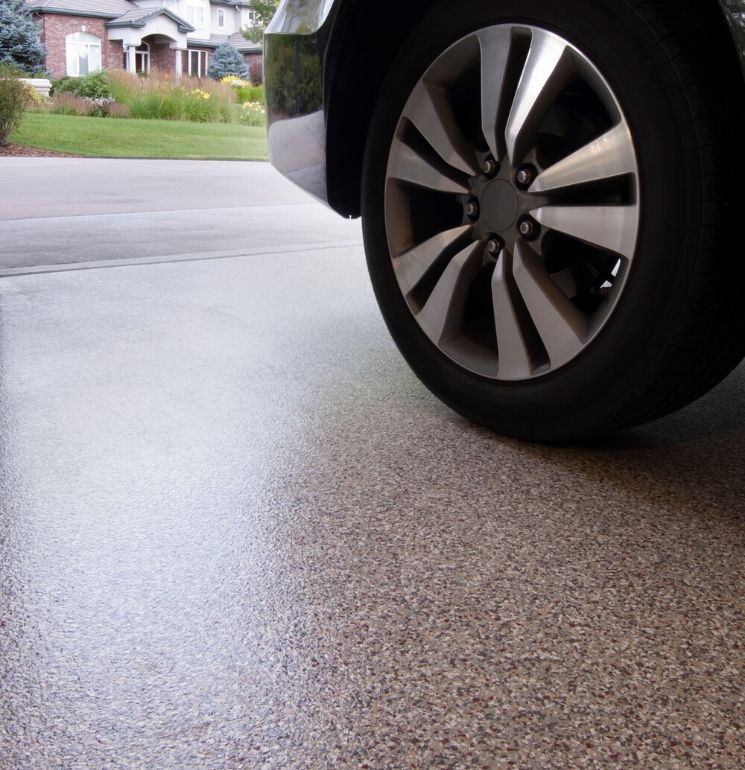Epoxy Coating
Epoxy refers to any of the basic components of cured end products of epoxy resins, often with favorable mechanical properties and high thermal and chemical resistance.
Epoxy coatings are normally applied over concrete floors to provide a high-performance, smooth, and durable surface that can last many years and withstand heavy loads.
Epoxy has a wide range of applications, including decorative flooring applications such as: flake, quartz, solid color, metallic, glitter and 3D logo applications.

Flake System
Epoxy has a wide range of applications, including decorative flooring applications such as: flake, quartz, solid color, metallic, glitter and 3D logo applications.

Quartz System
Epoxy has a wide range of applications, including decorative flooring applications such as: flake, quartz, solid color, metallic, glitter and 3D logo applications.

Metallic System
Epoxy has a wide range of applications, including decorative flooring applications such as: flake, quartz, solid color, metallic, glitter and 3D logo applications.

Glitter System
Epoxy has a wide range of applications, including decorative flooring applications such as: flake, quartz, solid color, metallic, glitter and 3D logo applications.

3D & logo design
Epoxy has a wide range of applications, including decorative flooring applications such as: flake, quartz, solid color, metallic, glitter and 3D logo applications.
Polished Concrete
Polished concrete is a multi-step process where a concrete floor is mechanically ground, honed and polished with bonded abrasives in order to cut a concrete floor’s surface. It is then refined with each cut in order to achieve a specified level of appearance. During concrete polishing, the surface is processed through a series of steps, utilizing progressively finer grinding tools.
The grinding tools are progressive grits of industrial diamonds in a bonded material such as metal/hybrid/resin often referred to as diamond polishing pads.
Polished concrete is a “green” flooring system.
Concrete is not considered polished before 400 grit and it is normally finished to either the 400, 800, 1500, or 3000 grit level.

Concrete Repair and Surface Preparation
Concrete repair is the process of fixing a hardened concrete surface that over time has lost the ability to hold the binding concrete materials together due to damage or environmental exposure. Concrete repair is appropriate for cracks, physical impacts, chipped out surfaces or surface scaling.
Surface preparation is the process of treating the surface of a substance in order to increase its adhesion to coatings. The single most important function that influences coating performance is the quality of surface preparation.

Grind & Seal
Using your concrete subfloor as your flooring can provide a durable, natural-looking surface. Exposed concrete can be used in any area where you want a sanitary, stunning space that’s easy to clean and maintain.
Grind and seal concrete systems finish your concrete floors so their striking, natural look can shine through. The final seal will ensure it can withstand wear and tear for years to come.
In fact, concrete that is properly grinded and sealed can last up to 100 years!
What Is Grind & Seal?
Grind and seal is a term used for the system of applying a clear, protective coating to concrete floors.
The grinding refers to the removal of any impurities or scratches in the surface layer of the concrete. This is accomplished using high-powered concrete grinders that quickly and efficiently saturate the surface of the concrete with scratches. For most grind and seal floors the concrete is refined to 70 grit.
After grinding, a clear, topical sealer is put on to protect the concrete. These sealing coats are usually made of epoxy or urethane.

Concrete Stain
Using your concrete subfloor as your flooring can provide a durable, natural-looking surface. Exposed concrete can be used in any area where you want a sanitary, stunning space that’s easy to clean and maintain.
Grind and seal concr
Self Leveling
Self-Leveling Concrete is a versatile, strong material that is used to make existing floors smoother, flatter, and stronger. Self-Leveling Concrete comes in two forms: underlayment and overlayment.

Underlayment and Overlayment
Underlayment
Underlayment material is used to level uneven, grooved, and/or heavily pitted floors in order to make them stable, flat and suitable for installation of sheet vinyl, vinyl tile, ceramic tile, hardwood or carpet. Underlayments may vary in depth from feather-edge to depths of 2 inches or more.
Overlayment
Overlayment or “wear-surface” concrete topping can be used to provide a floor with an entirely new, flat surface that can be polished, colored, or coated with epoxy. Numerous types of concrete overlayments are available and can be applied to depths of featheredge to 2-3 inches.
We are certified installers self leveling products and have experience in both surface preparation and final surface finishes.
Get a free quote today!
Interested In Our Professional Flooring Services?
Our gallerY
Recent Work
Newsletter
Subscribe for Flooring Resources & Store Discounts
Get a Quote in Under 24 Hrs
Request an Online Quote
Or Call: 848-202-8882




